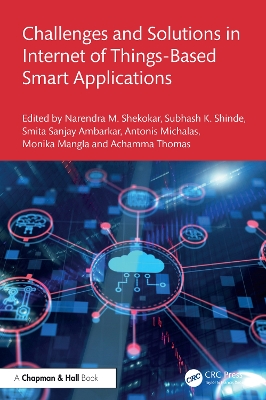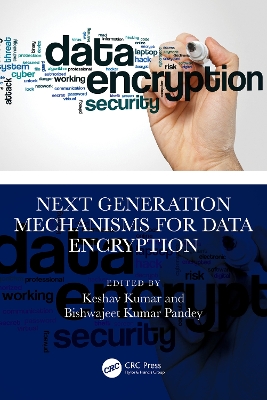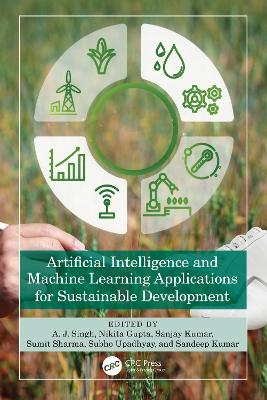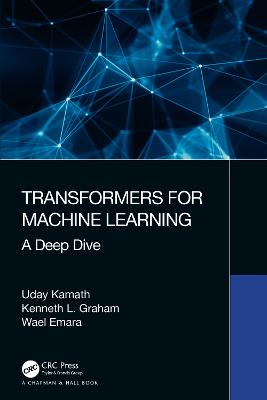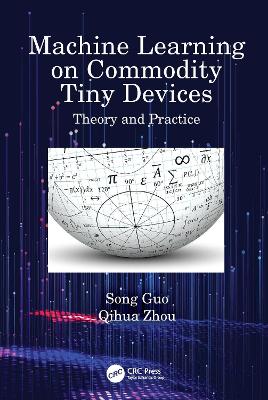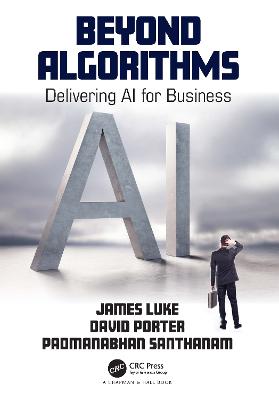Transformers for Machine Learning
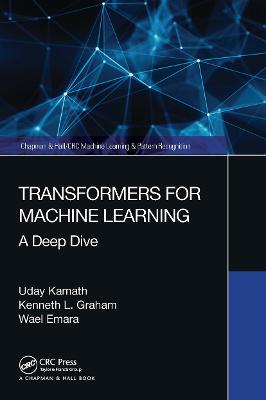 portes grátis
portes grátis
Transformers for Machine Learning
A Deep Dive
Emara, Wael; Kamath, Uday; Graham, Kenneth
Taylor & Francis Ltd
05/2022
257
Mole
Inglês
9780367767341
15 a 20 dias
453
Descrição não disponível.
List of Figures
List of Tables
Author Bios
Foreword
Preface
Contributors
Deep Learning and Transformers: An Introduction
1.1 DEEP LEARNING: A HISTORIC PERSPECTIVE
1.2 TRANSFORMERS AND TAXONOMY
1.2.1 Modified Transformer Architecture
1.2.1.1 Transformer block changes
1.2.1.2 Transformer sublayer changes
1.2.2 Pretraining Methods and Applications
1.3 RESOURCES
1.3.1 Libraries and Implementations
1.3.2 Books
1.3.3 Courses, Tutorials, and Lectures
1.3.4 Case Studies and Details
Transformers: Basics and Introduction
2.1 ENCODER-DECODER ARCHITECTURE
2.2 SEQUENCE TO SEQUENCE
2.2.1 Encoder
2.2.2 Decoder
2.2.3 Training
2.2.4 Issues with RNN-based Encoder Decoder
2.3 ATTENTION MECHANISM
2.3.1 Background
2.3.2 Types of Score-Based Attention
2.3.2.1 Dot Product (multiplicative)
2.3.2.2 Scaled Dot Product or multiplicative
2.3.2.3 Linear, MLP, or additive
2.3.3 Attention-based Sequence to Sequence
2.4 TRANSFORMER
2.4.1 Source and Target Representation
2.4.1.1 Word Embedding
2.4.1.2 Positional Encoding
2.4.2 Attention Layers
2.4.2.1 Self-Attention
2.4.2.2 Multi-Head Attention
2.4.2.3 Masked Multi-Head Attention
2.4.2.4 Encoder-Decoder Multi-Head Attention
2.4.3 Residuals and Layer Normalization
2.4.4 Position-wise Feed-Forward Networks
2.4.5 Encoder
2.4.6 Decoder
2.5 CASE STUDY: MACHINE TRANSLATION
2.5.1 Goal
2.5.2 Data, Tools and Libraries
2.5.3 Experiments, Results and Analysis
2.5.3.1 Exploratory Data Analysis
2.5.3.2 Attention
2.5.3.3 Transformer
2.5.3.4 Results and Analysis
2.5.3.5 Explainability
Bidirectional Encoder Representations from Transformers (BERT)
3.1 BERT
3.1.1 Architecture
3.1.2 Pre-training
3.1.3 Fine-tuning
3.2 BERT VARIANTS
3.2.1 RoBERTa
3.3 APPLICATIONS
3.3.1 TaBERT
3.3.2 BERTopic
3.4 BERT INSIGHTS
3.4.1 BERT Sentence Representation
3.4.2 BERTology
3.5 CASE STUDY: TOPIC MODELING WITH TRANSFORMERS
3.5.1 Goal
3.5.2 Data, Tools, and Libraries
3.5.2.1 Data
3.5.2.2 Compute embeddings
3.5.3 Experiments, Results, and Analysis
3.5.3.1 Building Topics
3.5.3.2 Topic size distribution
3.5.3.3 Visualization of topics
3.5.3.4 Content of topics
3.6 CASE STUDY: FINE-TUNING BERT
3.6.1 Goal
3.6.2 Data, Tools and Libraries
3.6.3 Experiments, Results and Analysis
Multilingual Transformer Architectures
4.1 MULTILINGUAL TRANSFORMER ARCHITECTURES
4.1.1 Basic Multilingual Transformer
4.1.2 Single-Encoder Multilingual NLU
4.1.2.1 mBERT
4.1.2.2 XLM
4.1.2.3 XLM-RoBERTa
4.1.2.4 ALM
4.1.2.5 Unicoder
4.1.2.6 INFOXL
4.1.2.7 AMBER
4.1.2.8 ERNIE-M
4.1.2.9 HITCL
4.1.3 Dual-Encoder Multilingual NLU
4.1.3.1 LaBSE
4.1.3.2 mUSE
4.1.4 Multilingual NLG
4.2 MULTILINGUAL DATA
4.2.1 Pre-training Data
4.2.2 Multilingual Benchmarks
4.2.2.1 Classification
4.2.2.2 Structure Prediction
4.2.2.3 Question Answering
4.2.2.4 Semantic Retrieval
4.3 MULTILINGUAL TRANSFER LEARNING INSIGHTS
4.3.1 Zero-shot Cross-lingual Learning
4.3.1.1 Data Factors
4.3.1.2 Model Architecture Factors
4.3.1.3 Model Tasks Factors
4.3.2 Language-agnostic Cross-lingual Representations
4.4 CASE STUDY
4.4.1 Goal
4.4.2 Data, Tools, and Libraries
4.4.3 Experiments, Results, and Analysis
4.4.3.1 Data Preprocessing
4.4.3.2 Experiments
Transformer Modifications
5.1 TRANSFORMER BLOCK MODIFICATIONS
5.1.1 Lightweight Transformers
5.1.1.1 Funnel-Transformer
5.1.1.2 DeLighT
5.1.2 Connections between Transformer Blocks
5.1.2.1 RealFormer
5.1.3 Adaptive Computation Time
5.1.3.1 Universal Transformers (UT)
5.1.4 Recurrence Relations between Transformer Blocks
5.1.4.1 Transformer-XL
5.1.5 Hierarchical Transformers
5.2 TRANSFORMERS WITH MODIFIED MULTI-HEAD SELF-ATTENTION
5.2.1 Structure of Multi-head Self-Attention
5.2.1.1 Multi-head self-attention
5.2.1.2 Space and time complexity
5.2.2 Reducing Complexity of Self-attention
5.2.2.1 Longformer
5.2.2.2 Reformer
5.2.2.3 Performer
5.2.2.4 Big Bird
5.2.3 Improving Multi-head-attention
5.2.3.1 Talking-Heads Attention
5.2.4 Biasing Attention with Priors
5.2.5 Prototype Queries
5.2.5.1 Clustered Attention
5.2.6 Compressed Key-Value Memory
5.2.6.1 Luna: Linear Unified Nested Attention
5.2.7 Low-rank Approximations
5.2.7.1 Linformer
5.3 MODIFICATIONS FOR TRAINING TASK EFFICIENCY
5.3.1 ELECTRA
5.3.1.1 Replaced token detection
5.3.2 T5
5.4 TRANSFORMER SUBMODULE CHANGES
5.4.1 Switch Transformer
5.5 CASE STUDY: SENTIMENT ANALYSIS
5.5.1 Goal
5.5.2 Data, Tools, and Libraries
5.5.3 Experiments, Results, and Analysis
5.5.3.1 Visualizing attention head weights
5.5.3.2 Analysis
Pretrained and Application-Specific Transformers
6.1 TEXT PROCESSING
6.1.1 Domain-Specific Transformers
6.1.1.1 BioBERT
6.1.1.2 SciBERT
6.1.1.3 FinBERT
6.1.2 Text-to-text Transformers
6.1.2.1 ByT5
6.1.3 Text generation
6.1.3.1 GPT: Generative Pre-training
6.1.3.2 GPT-2
6.1.3.3 GPT-3
6.2 COMPUTER VISION
6.2.1 Vision Transformer
6.3 AUTOMATIC SPEECH RECOGNITION
6.3.1 Wav2vec 2.0
6.3.2 Speech2Text2
6.3.3 HuBERT: Hidden Units BERT
6.4 MULTIMODAL AND MULTITASKING TRANSFORMER
6.4.1 Vision-and-Language BERT (VilBERT)
6.4.2 Unified Transformer (UniT)
6.5 VIDEO PROCESSING WITH TIMESFORMER
6.5.1 Patch embeddings
6.5.2 Self-attention
6.5.2.1 Spatiotemporal self-attention
6.5.2.2 Spatiotemporal attention blocks
6.6 GRAPH TRANSFORMERS
6.6.1 Positional encodings in a graph
6.6.1.1 Laplacian positional encodings
6.6.2 Graph transformer input
6.6.2.1 Graphs without edge attributes
6.6.2.2 Graphs with edge attributes
6.7 REINFORCEMENT LEARNING
6.7.1 Decision Transformer
6.8 CASE STUDY: AUTOMATIC SPEECH RECOGNITION
6.8.1 Goal
6.8.2 Data, Tools, and Libraries
6.8.3 Experiments, Results, and Analysis
6.8.3.1 Preprocessing speech data
6.8.3.2 Evaluation
Interpretability and Explainability Techniques for Transformers
7.1 TRAITS OF EXPLAINABLE SYSTEMS
7.2 RELATED AREAS THAT IMPACT EXPLAINABILITY
7.3 EXPLAINABLE METHODS TAXONOMY
7.3.1 Visualization Methods
7.3.1.1 Backpropagation-based
7.3.1.2 Perturbation-based
7.3.2 Model Distillation
7.3.2.1 Local Approximation
7.3.2.2 Model Translation
7.3.3 Intrinsic Methods
7.3.3.1 Probing Mechanism
7.3.3.2 Joint Training
7.4 ATTENTION AND EXPLANATION
7.4.1 Attention is not Explanation
7.4.1.1 Attention Weights and Feature Importance
7.4.1.2 Counterfactual Experiments
7.4.2 Attention is not not Explanation
7.4.2.1 Is attention necessary for all tasks?
7.4.2.2 Searching for Adversarial Models
7.4.2.3 Attention Probing
7.5 QUANTIFYING ATTENTION FLOW
7.5.1 Information flow as DAG
7.5.2 Attention Rollout
7.5.3 Attention Flow
7.6 CASE STUDY: TEXT CLASSIFICATION WITH EXPLAINABILITY
7.6.1 Goal
7.6.2 Data, Tools, and Libraries
7.6.3 Experiments, Results and Analysis
7.6.3.1 Exploratory Data Analysis
7.6.3.2 Experiments
7.6.3.3 Error Analysis and Explainability
Bibliography
Alphabetical Index
List of Tables
Author Bios
Foreword
Preface
Contributors
Deep Learning and Transformers: An Introduction
1.1 DEEP LEARNING: A HISTORIC PERSPECTIVE
1.2 TRANSFORMERS AND TAXONOMY
1.2.1 Modified Transformer Architecture
1.2.1.1 Transformer block changes
1.2.1.2 Transformer sublayer changes
1.2.2 Pretraining Methods and Applications
1.3 RESOURCES
1.3.1 Libraries and Implementations
1.3.2 Books
1.3.3 Courses, Tutorials, and Lectures
1.3.4 Case Studies and Details
Transformers: Basics and Introduction
2.1 ENCODER-DECODER ARCHITECTURE
2.2 SEQUENCE TO SEQUENCE
2.2.1 Encoder
2.2.2 Decoder
2.2.3 Training
2.2.4 Issues with RNN-based Encoder Decoder
2.3 ATTENTION MECHANISM
2.3.1 Background
2.3.2 Types of Score-Based Attention
2.3.2.1 Dot Product (multiplicative)
2.3.2.2 Scaled Dot Product or multiplicative
2.3.2.3 Linear, MLP, or additive
2.3.3 Attention-based Sequence to Sequence
2.4 TRANSFORMER
2.4.1 Source and Target Representation
2.4.1.1 Word Embedding
2.4.1.2 Positional Encoding
2.4.2 Attention Layers
2.4.2.1 Self-Attention
2.4.2.2 Multi-Head Attention
2.4.2.3 Masked Multi-Head Attention
2.4.2.4 Encoder-Decoder Multi-Head Attention
2.4.3 Residuals and Layer Normalization
2.4.4 Position-wise Feed-Forward Networks
2.4.5 Encoder
2.4.6 Decoder
2.5 CASE STUDY: MACHINE TRANSLATION
2.5.1 Goal
2.5.2 Data, Tools and Libraries
2.5.3 Experiments, Results and Analysis
2.5.3.1 Exploratory Data Analysis
2.5.3.2 Attention
2.5.3.3 Transformer
2.5.3.4 Results and Analysis
2.5.3.5 Explainability
Bidirectional Encoder Representations from Transformers (BERT)
3.1 BERT
3.1.1 Architecture
3.1.2 Pre-training
3.1.3 Fine-tuning
3.2 BERT VARIANTS
3.2.1 RoBERTa
3.3 APPLICATIONS
3.3.1 TaBERT
3.3.2 BERTopic
3.4 BERT INSIGHTS
3.4.1 BERT Sentence Representation
3.4.2 BERTology
3.5 CASE STUDY: TOPIC MODELING WITH TRANSFORMERS
3.5.1 Goal
3.5.2 Data, Tools, and Libraries
3.5.2.1 Data
3.5.2.2 Compute embeddings
3.5.3 Experiments, Results, and Analysis
3.5.3.1 Building Topics
3.5.3.2 Topic size distribution
3.5.3.3 Visualization of topics
3.5.3.4 Content of topics
3.6 CASE STUDY: FINE-TUNING BERT
3.6.1 Goal
3.6.2 Data, Tools and Libraries
3.6.3 Experiments, Results and Analysis
Multilingual Transformer Architectures
4.1 MULTILINGUAL TRANSFORMER ARCHITECTURES
4.1.1 Basic Multilingual Transformer
4.1.2 Single-Encoder Multilingual NLU
4.1.2.1 mBERT
4.1.2.2 XLM
4.1.2.3 XLM-RoBERTa
4.1.2.4 ALM
4.1.2.5 Unicoder
4.1.2.6 INFOXL
4.1.2.7 AMBER
4.1.2.8 ERNIE-M
4.1.2.9 HITCL
4.1.3 Dual-Encoder Multilingual NLU
4.1.3.1 LaBSE
4.1.3.2 mUSE
4.1.4 Multilingual NLG
4.2 MULTILINGUAL DATA
4.2.1 Pre-training Data
4.2.2 Multilingual Benchmarks
4.2.2.1 Classification
4.2.2.2 Structure Prediction
4.2.2.3 Question Answering
4.2.2.4 Semantic Retrieval
4.3 MULTILINGUAL TRANSFER LEARNING INSIGHTS
4.3.1 Zero-shot Cross-lingual Learning
4.3.1.1 Data Factors
4.3.1.2 Model Architecture Factors
4.3.1.3 Model Tasks Factors
4.3.2 Language-agnostic Cross-lingual Representations
4.4 CASE STUDY
4.4.1 Goal
4.4.2 Data, Tools, and Libraries
4.4.3 Experiments, Results, and Analysis
4.4.3.1 Data Preprocessing
4.4.3.2 Experiments
Transformer Modifications
5.1 TRANSFORMER BLOCK MODIFICATIONS
5.1.1 Lightweight Transformers
5.1.1.1 Funnel-Transformer
5.1.1.2 DeLighT
5.1.2 Connections between Transformer Blocks
5.1.2.1 RealFormer
5.1.3 Adaptive Computation Time
5.1.3.1 Universal Transformers (UT)
5.1.4 Recurrence Relations between Transformer Blocks
5.1.4.1 Transformer-XL
5.1.5 Hierarchical Transformers
5.2 TRANSFORMERS WITH MODIFIED MULTI-HEAD SELF-ATTENTION
5.2.1 Structure of Multi-head Self-Attention
5.2.1.1 Multi-head self-attention
5.2.1.2 Space and time complexity
5.2.2 Reducing Complexity of Self-attention
5.2.2.1 Longformer
5.2.2.2 Reformer
5.2.2.3 Performer
5.2.2.4 Big Bird
5.2.3 Improving Multi-head-attention
5.2.3.1 Talking-Heads Attention
5.2.4 Biasing Attention with Priors
5.2.5 Prototype Queries
5.2.5.1 Clustered Attention
5.2.6 Compressed Key-Value Memory
5.2.6.1 Luna: Linear Unified Nested Attention
5.2.7 Low-rank Approximations
5.2.7.1 Linformer
5.3 MODIFICATIONS FOR TRAINING TASK EFFICIENCY
5.3.1 ELECTRA
5.3.1.1 Replaced token detection
5.3.2 T5
5.4 TRANSFORMER SUBMODULE CHANGES
5.4.1 Switch Transformer
5.5 CASE STUDY: SENTIMENT ANALYSIS
5.5.1 Goal
5.5.2 Data, Tools, and Libraries
5.5.3 Experiments, Results, and Analysis
5.5.3.1 Visualizing attention head weights
5.5.3.2 Analysis
Pretrained and Application-Specific Transformers
6.1 TEXT PROCESSING
6.1.1 Domain-Specific Transformers
6.1.1.1 BioBERT
6.1.1.2 SciBERT
6.1.1.3 FinBERT
6.1.2 Text-to-text Transformers
6.1.2.1 ByT5
6.1.3 Text generation
6.1.3.1 GPT: Generative Pre-training
6.1.3.2 GPT-2
6.1.3.3 GPT-3
6.2 COMPUTER VISION
6.2.1 Vision Transformer
6.3 AUTOMATIC SPEECH RECOGNITION
6.3.1 Wav2vec 2.0
6.3.2 Speech2Text2
6.3.3 HuBERT: Hidden Units BERT
6.4 MULTIMODAL AND MULTITASKING TRANSFORMER
6.4.1 Vision-and-Language BERT (VilBERT)
6.4.2 Unified Transformer (UniT)
6.5 VIDEO PROCESSING WITH TIMESFORMER
6.5.1 Patch embeddings
6.5.2 Self-attention
6.5.2.1 Spatiotemporal self-attention
6.5.2.2 Spatiotemporal attention blocks
6.6 GRAPH TRANSFORMERS
6.6.1 Positional encodings in a graph
6.6.1.1 Laplacian positional encodings
6.6.2 Graph transformer input
6.6.2.1 Graphs without edge attributes
6.6.2.2 Graphs with edge attributes
6.7 REINFORCEMENT LEARNING
6.7.1 Decision Transformer
6.8 CASE STUDY: AUTOMATIC SPEECH RECOGNITION
6.8.1 Goal
6.8.2 Data, Tools, and Libraries
6.8.3 Experiments, Results, and Analysis
6.8.3.1 Preprocessing speech data
6.8.3.2 Evaluation
Interpretability and Explainability Techniques for Transformers
7.1 TRAITS OF EXPLAINABLE SYSTEMS
7.2 RELATED AREAS THAT IMPACT EXPLAINABILITY
7.3 EXPLAINABLE METHODS TAXONOMY
7.3.1 Visualization Methods
7.3.1.1 Backpropagation-based
7.3.1.2 Perturbation-based
7.3.2 Model Distillation
7.3.2.1 Local Approximation
7.3.2.2 Model Translation
7.3.3 Intrinsic Methods
7.3.3.1 Probing Mechanism
7.3.3.2 Joint Training
7.4 ATTENTION AND EXPLANATION
7.4.1 Attention is not Explanation
7.4.1.1 Attention Weights and Feature Importance
7.4.1.2 Counterfactual Experiments
7.4.2 Attention is not not Explanation
7.4.2.1 Is attention necessary for all tasks?
7.4.2.2 Searching for Adversarial Models
7.4.2.3 Attention Probing
7.5 QUANTIFYING ATTENTION FLOW
7.5.1 Information flow as DAG
7.5.2 Attention Rollout
7.5.3 Attention Flow
7.6 CASE STUDY: TEXT CLASSIFICATION WITH EXPLAINABILITY
7.6.1 Goal
7.6.2 Data, Tools, and Libraries
7.6.3 Experiments, Results and Analysis
7.6.3.1 Exploratory Data Analysis
7.6.3.2 Experiments
7.6.3.3 Error Analysis and Explainability
Bibliography
Alphabetical Index
Este título pertence ao(s) assunto(s) indicados(s). Para ver outros títulos clique no assunto desejado.
machine learning;transformers;artificial intelligence;deep learning;Multilingual Transformer Architectures;POS Tag;Positional Encodings;Shapley Values;Unsupervised Pre-training;Attention Mechanism;NLP Problem;Attention Weights;NLP Task;Attention Layers;Pre-training Data;Query Matrix;Highest Logit;Masked Tokens;Transformer Block;Machine Translation;Pre-trained Model;Downstream Tasks;Parallel Corpora;LSH;Temporal Attention;DBNs;Embedding Layer;Adjacency Matrix;RBMs;Standard Transformer
List of Figures
List of Tables
Author Bios
Foreword
Preface
Contributors
Deep Learning and Transformers: An Introduction
1.1 DEEP LEARNING: A HISTORIC PERSPECTIVE
1.2 TRANSFORMERS AND TAXONOMY
1.2.1 Modified Transformer Architecture
1.2.1.1 Transformer block changes
1.2.1.2 Transformer sublayer changes
1.2.2 Pretraining Methods and Applications
1.3 RESOURCES
1.3.1 Libraries and Implementations
1.3.2 Books
1.3.3 Courses, Tutorials, and Lectures
1.3.4 Case Studies and Details
Transformers: Basics and Introduction
2.1 ENCODER-DECODER ARCHITECTURE
2.2 SEQUENCE TO SEQUENCE
2.2.1 Encoder
2.2.2 Decoder
2.2.3 Training
2.2.4 Issues with RNN-based Encoder Decoder
2.3 ATTENTION MECHANISM
2.3.1 Background
2.3.2 Types of Score-Based Attention
2.3.2.1 Dot Product (multiplicative)
2.3.2.2 Scaled Dot Product or multiplicative
2.3.2.3 Linear, MLP, or additive
2.3.3 Attention-based Sequence to Sequence
2.4 TRANSFORMER
2.4.1 Source and Target Representation
2.4.1.1 Word Embedding
2.4.1.2 Positional Encoding
2.4.2 Attention Layers
2.4.2.1 Self-Attention
2.4.2.2 Multi-Head Attention
2.4.2.3 Masked Multi-Head Attention
2.4.2.4 Encoder-Decoder Multi-Head Attention
2.4.3 Residuals and Layer Normalization
2.4.4 Position-wise Feed-Forward Networks
2.4.5 Encoder
2.4.6 Decoder
2.5 CASE STUDY: MACHINE TRANSLATION
2.5.1 Goal
2.5.2 Data, Tools and Libraries
2.5.3 Experiments, Results and Analysis
2.5.3.1 Exploratory Data Analysis
2.5.3.2 Attention
2.5.3.3 Transformer
2.5.3.4 Results and Analysis
2.5.3.5 Explainability
Bidirectional Encoder Representations from Transformers (BERT)
3.1 BERT
3.1.1 Architecture
3.1.2 Pre-training
3.1.3 Fine-tuning
3.2 BERT VARIANTS
3.2.1 RoBERTa
3.3 APPLICATIONS
3.3.1 TaBERT
3.3.2 BERTopic
3.4 BERT INSIGHTS
3.4.1 BERT Sentence Representation
3.4.2 BERTology
3.5 CASE STUDY: TOPIC MODELING WITH TRANSFORMERS
3.5.1 Goal
3.5.2 Data, Tools, and Libraries
3.5.2.1 Data
3.5.2.2 Compute embeddings
3.5.3 Experiments, Results, and Analysis
3.5.3.1 Building Topics
3.5.3.2 Topic size distribution
3.5.3.3 Visualization of topics
3.5.3.4 Content of topics
3.6 CASE STUDY: FINE-TUNING BERT
3.6.1 Goal
3.6.2 Data, Tools and Libraries
3.6.3 Experiments, Results and Analysis
Multilingual Transformer Architectures
4.1 MULTILINGUAL TRANSFORMER ARCHITECTURES
4.1.1 Basic Multilingual Transformer
4.1.2 Single-Encoder Multilingual NLU
4.1.2.1 mBERT
4.1.2.2 XLM
4.1.2.3 XLM-RoBERTa
4.1.2.4 ALM
4.1.2.5 Unicoder
4.1.2.6 INFOXL
4.1.2.7 AMBER
4.1.2.8 ERNIE-M
4.1.2.9 HITCL
4.1.3 Dual-Encoder Multilingual NLU
4.1.3.1 LaBSE
4.1.3.2 mUSE
4.1.4 Multilingual NLG
4.2 MULTILINGUAL DATA
4.2.1 Pre-training Data
4.2.2 Multilingual Benchmarks
4.2.2.1 Classification
4.2.2.2 Structure Prediction
4.2.2.3 Question Answering
4.2.2.4 Semantic Retrieval
4.3 MULTILINGUAL TRANSFER LEARNING INSIGHTS
4.3.1 Zero-shot Cross-lingual Learning
4.3.1.1 Data Factors
4.3.1.2 Model Architecture Factors
4.3.1.3 Model Tasks Factors
4.3.2 Language-agnostic Cross-lingual Representations
4.4 CASE STUDY
4.4.1 Goal
4.4.2 Data, Tools, and Libraries
4.4.3 Experiments, Results, and Analysis
4.4.3.1 Data Preprocessing
4.4.3.2 Experiments
Transformer Modifications
5.1 TRANSFORMER BLOCK MODIFICATIONS
5.1.1 Lightweight Transformers
5.1.1.1 Funnel-Transformer
5.1.1.2 DeLighT
5.1.2 Connections between Transformer Blocks
5.1.2.1 RealFormer
5.1.3 Adaptive Computation Time
5.1.3.1 Universal Transformers (UT)
5.1.4 Recurrence Relations between Transformer Blocks
5.1.4.1 Transformer-XL
5.1.5 Hierarchical Transformers
5.2 TRANSFORMERS WITH MODIFIED MULTI-HEAD SELF-ATTENTION
5.2.1 Structure of Multi-head Self-Attention
5.2.1.1 Multi-head self-attention
5.2.1.2 Space and time complexity
5.2.2 Reducing Complexity of Self-attention
5.2.2.1 Longformer
5.2.2.2 Reformer
5.2.2.3 Performer
5.2.2.4 Big Bird
5.2.3 Improving Multi-head-attention
5.2.3.1 Talking-Heads Attention
5.2.4 Biasing Attention with Priors
5.2.5 Prototype Queries
5.2.5.1 Clustered Attention
5.2.6 Compressed Key-Value Memory
5.2.6.1 Luna: Linear Unified Nested Attention
5.2.7 Low-rank Approximations
5.2.7.1 Linformer
5.3 MODIFICATIONS FOR TRAINING TASK EFFICIENCY
5.3.1 ELECTRA
5.3.1.1 Replaced token detection
5.3.2 T5
5.4 TRANSFORMER SUBMODULE CHANGES
5.4.1 Switch Transformer
5.5 CASE STUDY: SENTIMENT ANALYSIS
5.5.1 Goal
5.5.2 Data, Tools, and Libraries
5.5.3 Experiments, Results, and Analysis
5.5.3.1 Visualizing attention head weights
5.5.3.2 Analysis
Pretrained and Application-Specific Transformers
6.1 TEXT PROCESSING
6.1.1 Domain-Specific Transformers
6.1.1.1 BioBERT
6.1.1.2 SciBERT
6.1.1.3 FinBERT
6.1.2 Text-to-text Transformers
6.1.2.1 ByT5
6.1.3 Text generation
6.1.3.1 GPT: Generative Pre-training
6.1.3.2 GPT-2
6.1.3.3 GPT-3
6.2 COMPUTER VISION
6.2.1 Vision Transformer
6.3 AUTOMATIC SPEECH RECOGNITION
6.3.1 Wav2vec 2.0
6.3.2 Speech2Text2
6.3.3 HuBERT: Hidden Units BERT
6.4 MULTIMODAL AND MULTITASKING TRANSFORMER
6.4.1 Vision-and-Language BERT (VilBERT)
6.4.2 Unified Transformer (UniT)
6.5 VIDEO PROCESSING WITH TIMESFORMER
6.5.1 Patch embeddings
6.5.2 Self-attention
6.5.2.1 Spatiotemporal self-attention
6.5.2.2 Spatiotemporal attention blocks
6.6 GRAPH TRANSFORMERS
6.6.1 Positional encodings in a graph
6.6.1.1 Laplacian positional encodings
6.6.2 Graph transformer input
6.6.2.1 Graphs without edge attributes
6.6.2.2 Graphs with edge attributes
6.7 REINFORCEMENT LEARNING
6.7.1 Decision Transformer
6.8 CASE STUDY: AUTOMATIC SPEECH RECOGNITION
6.8.1 Goal
6.8.2 Data, Tools, and Libraries
6.8.3 Experiments, Results, and Analysis
6.8.3.1 Preprocessing speech data
6.8.3.2 Evaluation
Interpretability and Explainability Techniques for Transformers
7.1 TRAITS OF EXPLAINABLE SYSTEMS
7.2 RELATED AREAS THAT IMPACT EXPLAINABILITY
7.3 EXPLAINABLE METHODS TAXONOMY
7.3.1 Visualization Methods
7.3.1.1 Backpropagation-based
7.3.1.2 Perturbation-based
7.3.2 Model Distillation
7.3.2.1 Local Approximation
7.3.2.2 Model Translation
7.3.3 Intrinsic Methods
7.3.3.1 Probing Mechanism
7.3.3.2 Joint Training
7.4 ATTENTION AND EXPLANATION
7.4.1 Attention is not Explanation
7.4.1.1 Attention Weights and Feature Importance
7.4.1.2 Counterfactual Experiments
7.4.2 Attention is not not Explanation
7.4.2.1 Is attention necessary for all tasks?
7.4.2.2 Searching for Adversarial Models
7.4.2.3 Attention Probing
7.5 QUANTIFYING ATTENTION FLOW
7.5.1 Information flow as DAG
7.5.2 Attention Rollout
7.5.3 Attention Flow
7.6 CASE STUDY: TEXT CLASSIFICATION WITH EXPLAINABILITY
7.6.1 Goal
7.6.2 Data, Tools, and Libraries
7.6.3 Experiments, Results and Analysis
7.6.3.1 Exploratory Data Analysis
7.6.3.2 Experiments
7.6.3.3 Error Analysis and Explainability
Bibliography
Alphabetical Index
List of Tables
Author Bios
Foreword
Preface
Contributors
Deep Learning and Transformers: An Introduction
1.1 DEEP LEARNING: A HISTORIC PERSPECTIVE
1.2 TRANSFORMERS AND TAXONOMY
1.2.1 Modified Transformer Architecture
1.2.1.1 Transformer block changes
1.2.1.2 Transformer sublayer changes
1.2.2 Pretraining Methods and Applications
1.3 RESOURCES
1.3.1 Libraries and Implementations
1.3.2 Books
1.3.3 Courses, Tutorials, and Lectures
1.3.4 Case Studies and Details
Transformers: Basics and Introduction
2.1 ENCODER-DECODER ARCHITECTURE
2.2 SEQUENCE TO SEQUENCE
2.2.1 Encoder
2.2.2 Decoder
2.2.3 Training
2.2.4 Issues with RNN-based Encoder Decoder
2.3 ATTENTION MECHANISM
2.3.1 Background
2.3.2 Types of Score-Based Attention
2.3.2.1 Dot Product (multiplicative)
2.3.2.2 Scaled Dot Product or multiplicative
2.3.2.3 Linear, MLP, or additive
2.3.3 Attention-based Sequence to Sequence
2.4 TRANSFORMER
2.4.1 Source and Target Representation
2.4.1.1 Word Embedding
2.4.1.2 Positional Encoding
2.4.2 Attention Layers
2.4.2.1 Self-Attention
2.4.2.2 Multi-Head Attention
2.4.2.3 Masked Multi-Head Attention
2.4.2.4 Encoder-Decoder Multi-Head Attention
2.4.3 Residuals and Layer Normalization
2.4.4 Position-wise Feed-Forward Networks
2.4.5 Encoder
2.4.6 Decoder
2.5 CASE STUDY: MACHINE TRANSLATION
2.5.1 Goal
2.5.2 Data, Tools and Libraries
2.5.3 Experiments, Results and Analysis
2.5.3.1 Exploratory Data Analysis
2.5.3.2 Attention
2.5.3.3 Transformer
2.5.3.4 Results and Analysis
2.5.3.5 Explainability
Bidirectional Encoder Representations from Transformers (BERT)
3.1 BERT
3.1.1 Architecture
3.1.2 Pre-training
3.1.3 Fine-tuning
3.2 BERT VARIANTS
3.2.1 RoBERTa
3.3 APPLICATIONS
3.3.1 TaBERT
3.3.2 BERTopic
3.4 BERT INSIGHTS
3.4.1 BERT Sentence Representation
3.4.2 BERTology
3.5 CASE STUDY: TOPIC MODELING WITH TRANSFORMERS
3.5.1 Goal
3.5.2 Data, Tools, and Libraries
3.5.2.1 Data
3.5.2.2 Compute embeddings
3.5.3 Experiments, Results, and Analysis
3.5.3.1 Building Topics
3.5.3.2 Topic size distribution
3.5.3.3 Visualization of topics
3.5.3.4 Content of topics
3.6 CASE STUDY: FINE-TUNING BERT
3.6.1 Goal
3.6.2 Data, Tools and Libraries
3.6.3 Experiments, Results and Analysis
Multilingual Transformer Architectures
4.1 MULTILINGUAL TRANSFORMER ARCHITECTURES
4.1.1 Basic Multilingual Transformer
4.1.2 Single-Encoder Multilingual NLU
4.1.2.1 mBERT
4.1.2.2 XLM
4.1.2.3 XLM-RoBERTa
4.1.2.4 ALM
4.1.2.5 Unicoder
4.1.2.6 INFOXL
4.1.2.7 AMBER
4.1.2.8 ERNIE-M
4.1.2.9 HITCL
4.1.3 Dual-Encoder Multilingual NLU
4.1.3.1 LaBSE
4.1.3.2 mUSE
4.1.4 Multilingual NLG
4.2 MULTILINGUAL DATA
4.2.1 Pre-training Data
4.2.2 Multilingual Benchmarks
4.2.2.1 Classification
4.2.2.2 Structure Prediction
4.2.2.3 Question Answering
4.2.2.4 Semantic Retrieval
4.3 MULTILINGUAL TRANSFER LEARNING INSIGHTS
4.3.1 Zero-shot Cross-lingual Learning
4.3.1.1 Data Factors
4.3.1.2 Model Architecture Factors
4.3.1.3 Model Tasks Factors
4.3.2 Language-agnostic Cross-lingual Representations
4.4 CASE STUDY
4.4.1 Goal
4.4.2 Data, Tools, and Libraries
4.4.3 Experiments, Results, and Analysis
4.4.3.1 Data Preprocessing
4.4.3.2 Experiments
Transformer Modifications
5.1 TRANSFORMER BLOCK MODIFICATIONS
5.1.1 Lightweight Transformers
5.1.1.1 Funnel-Transformer
5.1.1.2 DeLighT
5.1.2 Connections between Transformer Blocks
5.1.2.1 RealFormer
5.1.3 Adaptive Computation Time
5.1.3.1 Universal Transformers (UT)
5.1.4 Recurrence Relations between Transformer Blocks
5.1.4.1 Transformer-XL
5.1.5 Hierarchical Transformers
5.2 TRANSFORMERS WITH MODIFIED MULTI-HEAD SELF-ATTENTION
5.2.1 Structure of Multi-head Self-Attention
5.2.1.1 Multi-head self-attention
5.2.1.2 Space and time complexity
5.2.2 Reducing Complexity of Self-attention
5.2.2.1 Longformer
5.2.2.2 Reformer
5.2.2.3 Performer
5.2.2.4 Big Bird
5.2.3 Improving Multi-head-attention
5.2.3.1 Talking-Heads Attention
5.2.4 Biasing Attention with Priors
5.2.5 Prototype Queries
5.2.5.1 Clustered Attention
5.2.6 Compressed Key-Value Memory
5.2.6.1 Luna: Linear Unified Nested Attention
5.2.7 Low-rank Approximations
5.2.7.1 Linformer
5.3 MODIFICATIONS FOR TRAINING TASK EFFICIENCY
5.3.1 ELECTRA
5.3.1.1 Replaced token detection
5.3.2 T5
5.4 TRANSFORMER SUBMODULE CHANGES
5.4.1 Switch Transformer
5.5 CASE STUDY: SENTIMENT ANALYSIS
5.5.1 Goal
5.5.2 Data, Tools, and Libraries
5.5.3 Experiments, Results, and Analysis
5.5.3.1 Visualizing attention head weights
5.5.3.2 Analysis
Pretrained and Application-Specific Transformers
6.1 TEXT PROCESSING
6.1.1 Domain-Specific Transformers
6.1.1.1 BioBERT
6.1.1.2 SciBERT
6.1.1.3 FinBERT
6.1.2 Text-to-text Transformers
6.1.2.1 ByT5
6.1.3 Text generation
6.1.3.1 GPT: Generative Pre-training
6.1.3.2 GPT-2
6.1.3.3 GPT-3
6.2 COMPUTER VISION
6.2.1 Vision Transformer
6.3 AUTOMATIC SPEECH RECOGNITION
6.3.1 Wav2vec 2.0
6.3.2 Speech2Text2
6.3.3 HuBERT: Hidden Units BERT
6.4 MULTIMODAL AND MULTITASKING TRANSFORMER
6.4.1 Vision-and-Language BERT (VilBERT)
6.4.2 Unified Transformer (UniT)
6.5 VIDEO PROCESSING WITH TIMESFORMER
6.5.1 Patch embeddings
6.5.2 Self-attention
6.5.2.1 Spatiotemporal self-attention
6.5.2.2 Spatiotemporal attention blocks
6.6 GRAPH TRANSFORMERS
6.6.1 Positional encodings in a graph
6.6.1.1 Laplacian positional encodings
6.6.2 Graph transformer input
6.6.2.1 Graphs without edge attributes
6.6.2.2 Graphs with edge attributes
6.7 REINFORCEMENT LEARNING
6.7.1 Decision Transformer
6.8 CASE STUDY: AUTOMATIC SPEECH RECOGNITION
6.8.1 Goal
6.8.2 Data, Tools, and Libraries
6.8.3 Experiments, Results, and Analysis
6.8.3.1 Preprocessing speech data
6.8.3.2 Evaluation
Interpretability and Explainability Techniques for Transformers
7.1 TRAITS OF EXPLAINABLE SYSTEMS
7.2 RELATED AREAS THAT IMPACT EXPLAINABILITY
7.3 EXPLAINABLE METHODS TAXONOMY
7.3.1 Visualization Methods
7.3.1.1 Backpropagation-based
7.3.1.2 Perturbation-based
7.3.2 Model Distillation
7.3.2.1 Local Approximation
7.3.2.2 Model Translation
7.3.3 Intrinsic Methods
7.3.3.1 Probing Mechanism
7.3.3.2 Joint Training
7.4 ATTENTION AND EXPLANATION
7.4.1 Attention is not Explanation
7.4.1.1 Attention Weights and Feature Importance
7.4.1.2 Counterfactual Experiments
7.4.2 Attention is not not Explanation
7.4.2.1 Is attention necessary for all tasks?
7.4.2.2 Searching for Adversarial Models
7.4.2.3 Attention Probing
7.5 QUANTIFYING ATTENTION FLOW
7.5.1 Information flow as DAG
7.5.2 Attention Rollout
7.5.3 Attention Flow
7.6 CASE STUDY: TEXT CLASSIFICATION WITH EXPLAINABILITY
7.6.1 Goal
7.6.2 Data, Tools, and Libraries
7.6.3 Experiments, Results and Analysis
7.6.3.1 Exploratory Data Analysis
7.6.3.2 Experiments
7.6.3.3 Error Analysis and Explainability
Bibliography
Alphabetical Index
Este título pertence ao(s) assunto(s) indicados(s). Para ver outros títulos clique no assunto desejado.
machine learning;transformers;artificial intelligence;deep learning;Multilingual Transformer Architectures;POS Tag;Positional Encodings;Shapley Values;Unsupervised Pre-training;Attention Mechanism;NLP Problem;Attention Weights;NLP Task;Attention Layers;Pre-training Data;Query Matrix;Highest Logit;Masked Tokens;Transformer Block;Machine Translation;Pre-trained Model;Downstream Tasks;Parallel Corpora;LSH;Temporal Attention;DBNs;Embedding Layer;Adjacency Matrix;RBMs;Standard Transformer

